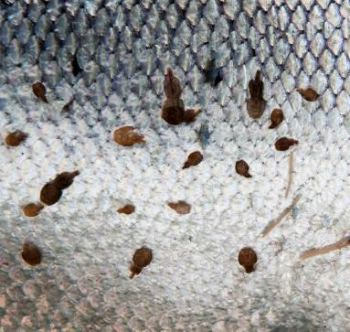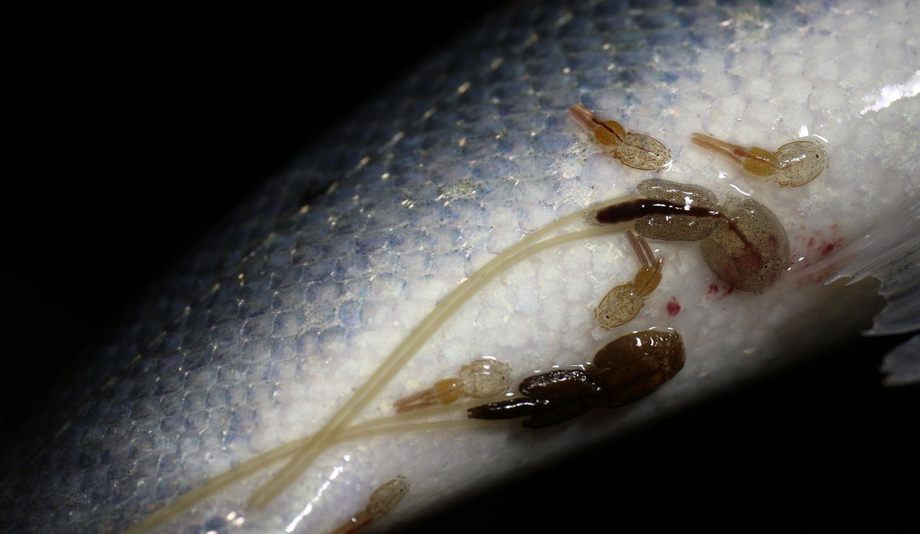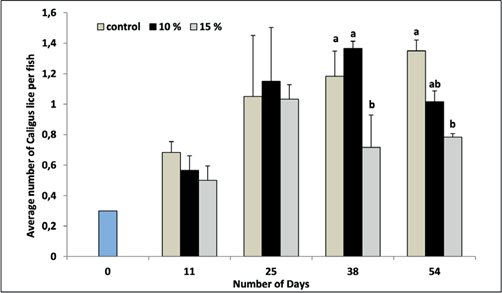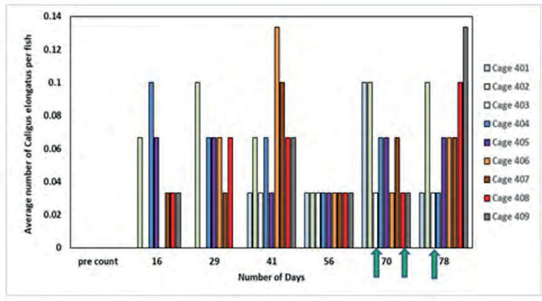|

Salmon lice are becoming increasingly expensive for salmon farmers. (Photo: courtesy Marit Hommedal / Scanpix)
Can we use lumpfish against scabies sea lices?
 NORWAY
NORWAY
Monday, October 19, 2020, 02:00 (GMT + 9)
The following is an article published by Akvaplan-Niva:
Akvaplan-niva has recently completed an FHF-funded project on scabies where the purpose has been to map the knowledge and experience base about scabies in salmon farming and to prioritize further research needs. In this article, we try to systematize existing knowledge about the use of lumpfish against scabies with the aim of being able to uncover any connection between the use of cleaner fish and the occurrence of scabies (The article has previously been published in Norsk Fiskeoppdrett).
Authors: Albert KD Imsland, Mette Remen, Kjetil Sagerup, Karin Bloch-Hansen: Akvaplan-niva. Willy Hemmingsen: University of Tromsø. Elisabeth Ann Myklebust: Cemaq, Finnmark. Remi Mathisen: Nordlaks. Patrick Reynolds: GIFAS.

Salmon sea lice and Scabies sea lice (Photo: courtesy Rune Nilsen)
Farmed salmon lice are a growing problem, especially in the northern parts of the country. Scabies sea lices (Caligus elongatus) differs from salmon lice (Lepeophtheirus salmonis) in terms of morphology, behavior and surcharge patterns, and it is therefore not a given that measures used against salmon lice are equally effective against sea lices. In contrast to salmon lice, scabies sea lices is also found in a number of fish species other than salmon (Kabata, 1979). Scabies sea lices are considered to be much better swimmers than salmon lice and it has been shown that adult scabies have the ability to re-infect other species of fish if it is removed from the original host (Øines et al. 2006). Adult scabies can therefore be transmitted from species such as lumpfish or saithe, which is a plausible explanation for the observations of rapid increases in scabies in salmon. Studies on wild fish along the coast of Norway showed that scabies were found in 27 of 52 species studied and usually with a higher amount in the autumn (Heuch et al., 2007). The study also showed that wild lumpfish are a preferred host, followed by cod and flatfish (plaice). Adult stages of scabies sea lices are smaller than adult salmon lice (Piasecki, 1996), and females in particular are significantly smaller than the adult female salmon lice.

Photo: courtesy Institutt for biovitenskap Universitetet I Bergen
Lumpfish are now widely used for biological de-lice in Nordland, Troms and Finnmark (Imsland et al., 2018), but until now knowledge about the effect of lumpfish on the occurrence of scabies is fragmented and there are no uniform guidelines on the use of lumpfish against scabies. Akvaplan-niva has, together with its partners, for a number of years carried out several small- and large-scale studies on the use of lumpfish as biological lice on salmon. In these experiments, the focus has been on common salmon lice, while data on scabies have also been collected. In the following article, we will summarize the knowledge based on these experiments.

There is no doubt that lumpfish eat scabies sea lice, but more knowledge is still needed. Photo: Tonje Cecilie Urskog / Grieg Seafood Finnmark
Experiment 1. Different mixing of lumpfish: effect on the occurrence of scabies
Method
To assess the efficiency of lumpfish grazing lice from Atlantic salmon, six small-scale cages (5 × 5 × 5m) were each added 120 salmon with an average weight of 619 g. Two of the cages were further filled with 12 lumpfish (10% density) and two cages with 18 lumpfish (15% density) which had an average weight of 54 g. Two cages without lumpfish served as a control.
At the start of the experiment, a lice count was performed when the fish were transferred to the cages, and lice were counted on 30 fish every 14 days throughout the experimental period. Any lice in the anesthetic container were also detected.
Results / discussion
At day 38, salmon in the cages with 15% lumpfish had a significantly smaller number of scales per salmon compared with both the control group and the 10% lumpfish group ( Figure 1. , P <0.05). A similar trend was seen on day 54 where salmon in 15% The lumpfish group had significantly fewer scales compared to the control group. 15% admixture of lumpfish resulted in 40-50% less scabies on salmon, compared with the control group. Similar trends have been found for common salmon lice (Imsland et al., 2014a) where salmon lice were actively grazed, which resulted in lower average numbers of salmon lice. pr. fish of mobile stages and sexually mature females when lumpfish were present in the cages.

Figure 1. Average number of scale lice, Caligus elongatus , per salmon recorded for each duplicate treatment at each sampling time. The values represent mean ± SD. Different letters above the bars indicate statistical difference (P <0.05).
Experiment 2. Accustoming of lumpfish to live feed: effect on the occurrence of scabies
Method
In this experiment, it was investigated whether different feeding regimes at the fry stage can stimulate increased interest in salmon lice in the sea phase. Two groups of juvenile lumpfish (10 g) were fed on either standard marine dry food or on a mixture of adult Artemia and frozen salmon lice and scab for 12 weeks. After that, the groups were moved to experimental cages (5x5x5 m). Three groups were established: a) salmon and lumpfish fed on marine dry feed (MF group); b) salmon and lumpfish fed with live (Artemia and frozen lice) feed (LF group); c) control group of salmon without lumpfish present (control group). The growth and number of scabies on salmon were examined regularly during the experimental period (63d).
Results / discussion
In this experiment, little lice (both species) were generally found. No scales were found at the start of the experiment (Figure 2). At day 34, a significantly smaller number of C. elongatus was found on salmon in both the LF and MF group compared to control ( P<0.05). At day 62 (end), 54% less scales were found on salmon in the LF group compared with control. There were 38% fewer scales in the LF group compared to the MF group, but the difference was not statistically significant. Although the number of scabies was low, the results indicate that both experimental groups (MF and LF) grazed on scabies throughout the experimental period. Effective lice eating even at low lice levels is important for biological control of lice in salmon farming. The results also indicate that early habituation to live feed can lead to increased grazing on live feed in lumpfish (including scabies) in salmon cages.
 number of scale lice, C_ elongatus per fish in the three experimental groups during the experimental period.png)
Figure 2. Average (± SD) number of scale lice, C. elongatus per fish in the three experimental groups during the experimental period. Mean values that do not divide a letter are significantly different.
Previous experiments with lumpfish have indicated that lice grazing increases over time (Imsland et al., 2014 a- c). This indicates learning. lumpfish that are conditioned for eating lice prior to release into the sea can therefore become more effective lice grazers. In other species, it has been indicated that live feed can lead to more "natural" behavior (Tanaka et al., 1998) or improve foraging (eating) by introducing new live feed (Massee et al., 2007) such as scabies. in this experiment.
Experiment 3. Is grazing on scabies hereditary?
A possible hereditary component of scabies eating has been investigated in two family trials.
Method
Family experiment A. In this experiment, nine genetically different families of lumpfish were used (SeImsland et al., 2016 for further details). At the start of the experiment, 40 fish from each of the nine family groups (n = 40, N = 360) were selected on the basis of their family affiliation and individual weight. After the selection, all fish were transferred to nine cages (5x5x5 m) at the GIFAS experimental facility at Langholmen, Nordland. Twenty lumpfish from each family were released into each cage and twenty into another cage so that duplicate treatments could be established for each genetic family. In each of the nine cages, 400 salmon with an average weight of 123 g were also released. Regular counts of scales on salmon were carried out throughout the experimental period.
Family experiment B. In this experiment, 10 genetic families produced at Akvaplaniva's research station at Kraknes (Troms) were used in the spring of 2018. To investigate the possible hereditary component of lice eating, these 10 families (N = 480, original weight 46.5 g) divided into 10 small-scale cages (5x5x5m). In each cage there were 400 salmon with an average weight of 387 g. Regular gastric lavages were performed (see Imsland et al., 2014a) in addition to counts of scales on the salmon.
Results / discussion
Family experiment A. Differences were found in the incidence of scales on salmon in the different experimental cages (Figure 3 ) and scab eating varied between the experimental families. In general, there was a lower number of scabies in the cages that had family no. 2 present, which may indicate a hereditary component.

Figure 3. Average number of scale lice, C. elongatus , on salmon in the various experimental cages in family experiment A (Imsland et al., 2016). The arrows show cages that contained family no.2.
Family experiment B. Grazing of scabies varied between families (Figure 4) in this experiment. Lice were found in the stomach of seven families (mainly adult females) at day 18. The proportion of examined lumpfish found with lice in the stomach varied from 2% to 11% on day 18. At day 62, a sharp increase was observed in number of lumpfish with scabies in the stomach where between 5% to 40% of fish from eight families were found with scabies in the stomach. Families 5 and 6 (half-siblings with the same father) had scabies in the stomach at all examined times and also had the most scabies in the stomach at all five examined times.

Figure 4. Percentage proportion of lumpfish found with scabies in the stomach of 10 lumpfish families at different meal points. Values are shown as mean ± SD.
Results from both experiments indicate that eating scabies may vary between different families. The families that ate the most lice (trial A - family 2 and trial B - families 5 and 6) were also the families that ate the most lice and had a behavior that can be described as well adapted to lice eating (Imsland et al., 2016). For family 2, up to 92% less lice were found on salmon in the cages where this family was present (Imsland et al., 2016). Although nutrient-rich salmon pellets were available to all families, family 2 in experiments A and families 5 and 6 showed a preference for other and less energy-rich prey compared to the other families. This confirms that the genetic influence on eating habits (including lice eating) can be strong (Imsland et al., 2016). Given the differences recorded in the intake of natural food sources between the families found most active in scallop eating and the other families, these lumpfish may be more prone to actively seek out natural food sources rather than salmon pellets. If this behavior is genetically determined, the genetic makeup of these families needs further research. Overall, the results from both family trials indicate that if these observed differences have a genetic basis, then selective breeding programs will be able to continue these favorable traits and be strengthened in future lumpfishpopulations. If this behavior is genetically determined, the genetic makeup of these families needs further research. Overall, the results from both family trials indicate that if these observed differences have a genetic basis, then selective breeding programs will be able to continue these favorable traits and be strengthened in future lumpfish populations. If this behavior is genetically determined, the genetic makeup of these families needs further research. Overall, the results from both family trials indicate that if these observed differences have a genetic basis, then selective breeding programs will be able to continue these favorable traits and be strengthened in future lumpfish populations.
Experiment 4. Effect of lumpfish on the occurrence of scabies:
large-scale experiments
Lerøy Aurora (locality Solheim)
Lerøy Aurora (locality Solheim). A large-scale experiment was conducted at the locality Solheim (Lerøy Aurora, Troms county, Norway) from 10 October 2015 to 16 May 2016. The experiment was conducted in eight large sea cages (160 m circumference, 37688 m3 volume) with 0+ smolts of Atlantic salmon (n = 193304 ± 2089 cages − 1) with an average weight of 198 g. On 10 October, lumpfishwere released in six cages with a density of 4, 6 and 8% respectively (8000, 12000 and 16000 pieces) which had an average weight of 25 g. Salmon lice and scabies were counted on 30 salmon per cage every 14 days during the trial period.
Results / discussion
Shellfish levels rose in all groups throughout the autumn (Figure 5). Significantly lower levels of scabies were found in the lumpfishgroups from the end of February to the beginning of April. During April, the level of scabies decreased in all the experimental groups and the final level of infection in May was in line with the levels observed in October the year before.
The relatively high number of scabies at Lerøy Aurora throughout the study period was typical of the entire locality. The scabies is known to move from fish to fish (Heuch et al., 2007). Despite the presence of lumpfish, there were a sufficiently high number of lice elsewhere on the site to allow a continuous reinfection in the cages with lumpfish. It is further approved that lumpfish are a preferred host for scabies (Øines et al. 2006; Mitamura et al., 2012).
, density of lumpfish registered for each duplicate treatment for each sampling time (every 14 days)_.png)
Figure 5. Prevalence of scabies per salmon in large-scale cages. Shown for 0% (control), 4%, 6% and 8% density of lumpfishregistered for each duplicate treatment for each sampling time (every 14 days).
Conclusions: connection between lumpfish and scabies
Available data clearly show that lumpfish graze on scabies and that this grazing can be increased both by getting used to live feed before sea release and by means of breeding. Adult stages of scabies (5-6 mm) are much smaller than adult female salmon lice (8-12 mm) while they are about the same size as adult male salmon lice. Previous experiments have clearly indicated a preference for the large female lice, but lumpfish are a distinct opportunist and actively eat the smaller stages, including male lice, in ordinary salmon lice. Our data indicate that this is also the case with scabies and that lumpfish can actively contribute to the fight against increased incidence of scabies.
References
Heuch, PA, Oines, O., Knutsen, JA, Schram, TA, 2007. Infection of wild fishes by theparasitic copepod Caligus elongatus on the south east coast of Norway. Haze. Aquat. Org. 77, 149-158.
Imsland, AK, Reynolds, P., Eliassen, G., Hangstad, TA, Foss, A., Vikingstad, E., Elvegård, TA, 2014a. The use of lumpfish ( Cyclopterus lumpus L.) to control sea lice ( Lepeophtheirus salmonis Krøyer) infestations in intensively farmed Atlantic salmon (Salmo salar L.). Aquaculture 425-426,18-23.
Imsland, AK, Reynolds, P., Eliassen, G., Hangstad, TA, Nytrø, AV, Foss, A., Vikingstad, E., Elvegård, TA, 2014b. Notes on behavior of lumpfish in sea pens with and without Atlantic salmon.Journal of Ethology32,117-122.
Imsland, AK, Reynolds, P., Eliassen, G., Hangstad, TA, Nytrø, AV, Foss, A., Vikingstad, E., Elvegård, TA, 2014c. Assessment of growth and sea lice infection levels in Atlantic salmon stocked in small-scale cages with lumpfish. Aquaculture 433, 137-142.
Imsland, AK, Reynolds, P., Eliassen, G., Mortensen, A., Hansen, Ø.J., Puvanendran, V., Hangstad, TA, Jónsdóttir, Ó.DB, Emaus, PA, Elvegård, TA, Lemmens , SCA, Rydland, R., Nytrø, AV, Jonassen, TM, 2016. Is cleaning behavior in lumpfish ( Cycloptherus lumpus ) parentally controlled? Aquaculture 459, 156-165.
Imsland, AK, Hanssen, A., Reynolds, P., Nytrø, AV, Jonassen, TM, Hangstad, TA, Elvegård, TA, Urskog, TC, Mikalsen, B. 2018. It works! Lumpfish can significantly lower sealice infections in large scale salmon farming Biology Open 7, 7, bio036301. doi: 10.1242 / bio.036301
Kabata, Z., 1979. Parasitic Copepoda of British fishes. The Ray Society, London.
Massee, KC, Kim, J., Berejikian, BA, Hardy, RW, 2007. Prey selection and efficiency of naive and experienced juvenile sockeye salmon. J.FishBiol 70,1213–1223.
Mitamura, H., Thorstad, EB, Uglem, I., Bjorn, PA, Okland, F., Naesje, TF, Dempster, T., Arai, N., 2012. Movements of lumpsucker females in a northern Norwegian fjord during the spawning season. Env.Biol.Fish. 93, 475-481.
Piasecki, W., 1996.The developmental stages of Caligus elongatus von Nordmann, 1832 (Copepoda: Caligidae). Can. J. Zool. 74,1459- 1478.
Tanaka, M., Seikai, T., Yamamoto, E., Furuta, S., 1998. Significance of larval and juvenile ecophysiology for stock enhancement of the Japanese founder, Paralichthysolivaceus . Bull. Mar. Sci. 62,551–571.
Øines, Ø., Simonsen, J., Knutsen, J., Heuch, P., 2006. Host preference of adult Caligus elongatus Nordmann in the laboratory and its implications for Atlantic cod aquaculture. J. Fish Dis. 29,167-174.
Contact person: Albert Kjartan / Dagbjartarson Imsland /R&D manager - aquaculture and seafood / Akvaplan-Niva (Article has been translated from original in Norwegian)

editorial@seafood.media
www.seafood.media
|
|



